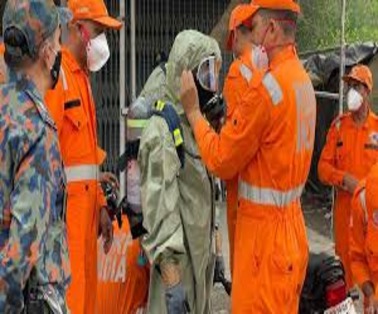After the tragic West Bengal rail accident, Union Minister of Railways Ashwini Vaishnaw has directed officials to fast-track the implementation of the Kavach system in mission mode. The move aims to strengthen India’s railway safety infrastructure and reduce the frequency of deadly train collisions and derailments.
Key Points
- During a review meeting focused on Kavach 4.0, Vaishnaw instructed officials to promptly equip all locomotives with the system once it is ready.
- According to the report, at present, three manufacturers are producing the Kavach system, while others are in different phases of development.
- The Ministry of Railways is working on Kavach installation on the Delhi-Mumbai and Delhi-Howrah routes. Tenders for an additional 6,000 km are expected to be issued by the end of this year, the report said.
- Most major railway networks globally transitioned to automatic train protection systems (ATP) similar to Kavach in the 1980s.
What is Kavach system?
- ‘Kavach’, which literally means armour, is the indigenous Automatic Train Protection (ATP) System
- It was developed in 2002 by the Research Designs and Standards Organisation (RDSO) in collaboration with three Indian vendors.
- The RDSO functions under the Railway Ministry.
- It was announced in the 2022 Union Budget as a part of the Atmanirbhar Bharat initiative.
- It has been adopted asNational Automatic Train Protection (ATP) System.
- It adheres toSafety Integrity Level-4 (SIL-4) standards and acts as a vigilant watchdog over the existing signaling system, alerting the loco pilot when approaching a ‘red signal’ and applying automatic brakes if necessary to prevent overshooting the signal.
- The system alsorelays SoS messages during emergency situations.
- The Kavach helps in case a locomotive pilot ignores signals and over-speeds.
How Does The Kavach System Work?
- Kavach operates by automatically applying brakes to trains if the driver does not respond promptly.
- It uses RFID (Radio Frequency Identification) tags placed along tracks and in station yards to determine track positions and train directions.
- When activated, trains within a 5-km radius stop to ensure the safe passage of nearby trains.
- During a successful test highlighted by Vaishnaw in 2022, Kavach demonstrated its ability to prevent rear-end collisions by automatically stopping a locomotive just 380 metres away from another in front.
- Furthermore, the system supports emergency communication by transmitting SoS messages during critical situations.
Key Features of the Kavach System
- Automatic brake application in case the locomotive pilot overrides signalling,
- better visibility in foggy conditions at higher speeds with line-side signal display in the cabin
- constant updates on movement,
- automatic whistling at level crossings,
- direct loco-to-loco communication to avoid collision, and
- an SOS feature in case of emergency situations.
Current Status of Kavach Implementation
- Kavach aims to secure India’s extensive railway network of over 68,000 km, but only 1,500 km are currently equipped with the system since its initial rollout.
- It costs ₹50 lakh per km for trackside installation and ₹70 lakh per train.
- It aims to cover 6,000 km by 2025, including key routes like Delhi-Mumbai and Delhi-Howrah.
- Upgrades are planned to make the system 4G/5G compatible.
- Installation is ongoing, with components like optical fiber cables, towers, and station equipment being deployed.
Government Push: Structured Rollout of Kavach 4.0
- Creation of special funds known as Rashtriya Rail Sanraksha Kosh (RRSK) and the Rail Safety Fund but also through capital grants it is permitted to utilise towards these essential requirements.
- Lighter and safer coaches for Mail/Express trains. These coaches are based on German technology and have better anti-climbing features, fire retardant materials, higher speed potential and longer service life than conventional ICF design coaches.
- Stronger and more durable tracks and bridges. This includes using a Prestressed Concrete Sleeper (PSC), higher Ultimate Tensile Strength (UTS) rails, fan-shaped layout turnout on PSC sleepers, Steel Channel Sleepers on girder bridges, etc.
- Improved design and features of coaches and wagons. This includes introducing Modified Centre Buffer Couplers, Bogie Mounted Air Brake System (BMBS), improved suspension design and provision of Automatic fire & smoke detection system in coaches.
- Indian Railways have installed Block Proving Axle Counter (BPAC) for better Railway traffic control. BPAC is a train detection system installed on trains, which automatically detects the crossing of a train between two points on the track.
- Project Mission Raftar is an Indian Railway project, introduced in the Railway Budget of 2016-17 and approved by NITI Aayog in 2017. The goal is to double the average speed of freight trains and increase passenger train speed by 50%.
- Mission Zero Accident comprises two sub-missions. Elimination of unmanned level crossings- The target is the elimination of all unmanned level crossings on Broad Gauge in the next 3-4 years. This will reduce deaths due to accidents and will improve the throughput of the network.
- TCAS (Train Collision Avoidance System)- A new technology has been developed to equip 100% of the High-Density Network with TCAS in the next 3 years. It will prevent head-on collisions and also improve throughput with increasing average sectional speeds.
Alarming Train Accident Statistics in India
- According to the National Crime Records Bureau, an average 23,000 people died every year between 2010 and 2021 in railway accidents.
- Derailments have been a major cause of train accidents in India. Lapses in safety protocols, track maintenance, and failure to identify and rectify track defects have resulted in derailments.
- Train collisions have occurred due to lapses in signalling systems, human errors, and failure to maintain safe distances between trains
- Justice Khanna or Railway Safety Review Committee, 1998: Led to the creation of a safety department in Indian Railways with officers and staff drawn from all disciplines.
- High Level Safety Review Committee under the chairmanship of Dr. Anil Kakodkar, 2012: Recommended switching over from the Integral Coach Factory (ICF) design coaches to the much safer LHB design coaches.
Recent Major Train Accidents in India
13 January 2022
The Bikaner-Guwahati Express derailed near New Domohani railway station in Mainaguri, Jalpaiguri, resulting in 9 deaths.
2 June 2023
The Odisha train collision involved the 12841 Coromandel Express colliding with a freight train in Odisha’s Balasore district, causing more than 1,200 injuries and 296 deaths.
23 August 2023
An under-construction railway bridge over the Kurung river on the Bairabi-Sairang line near Sairang, Mizoram, collapsed, killing at least 26 workers.
26 August 2023
A fire erupted in the Lucknow-Rameshwaram Bharat Gaurav train near Madurai Junction, killing 9 and injuring 20. The fire was caused by passengers smuggling a gas cylinder aboard the train.
11 October 2023
The 12506 Anand Vihar Terminal-Kamakhya Junction North East Express derailed near Raghunathpur Railway Station in Buxar district, Bihar, killing 4 and injuring more than 70.
29 October 2023
The Visakhapatnam-Rayagada passenger train collided with the Visakhapatnam-Palasa passenger train near Kottavalasa Junction railway station in Vizianagaram district, Andhra Pradesh, killing at least 14 and injuring 50.
28 February 2024
Two people were killed and several injured after being hit by a train near Kalajhariya in Jharkhand’s Jamtara-Karmatand.
17 June 2024
A freight train collided with the Kanchanjunga Express (13174) near Rangapani railway station, approximately 10 km from New Jalpaiguri railway station in West Bengal, killing 15 and injuring at least 60.
Conclusion: Kavach Is Critical for Railway Safety Reform
With the increasing frequency of tragic train accidents, Kavach is not just a safety upgrade—it is a necessity. As India modernizes its railway network, accelerating the deployment of Kavach will be vital to prevent further loss of life and ensure safer, smarter, and more resilient rail transport.
To Download Monthly Current Affairs PDF Click here
Click here to get a free demo
Discover all about CLAT Exam



